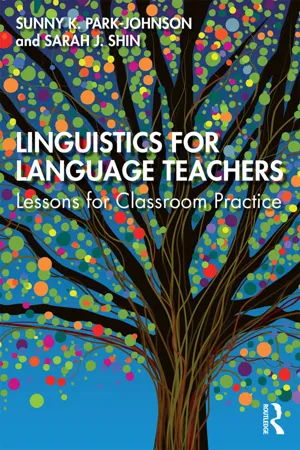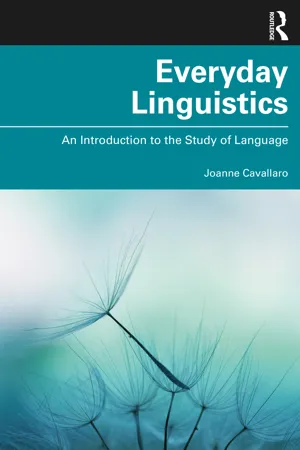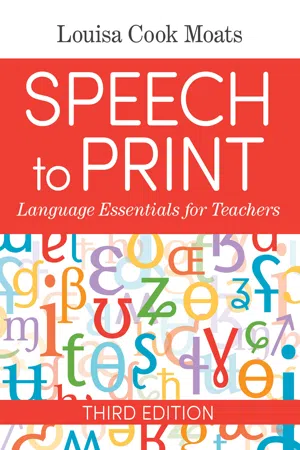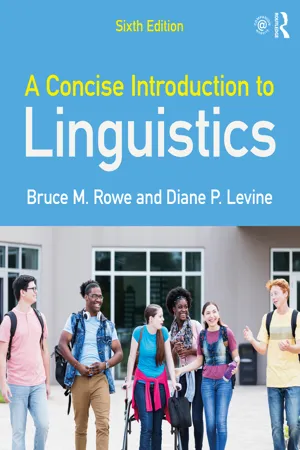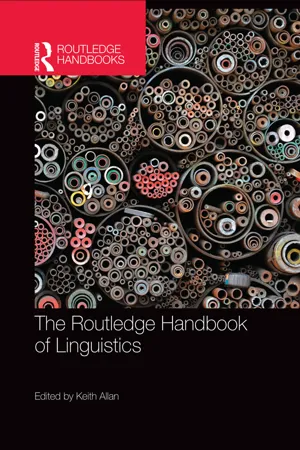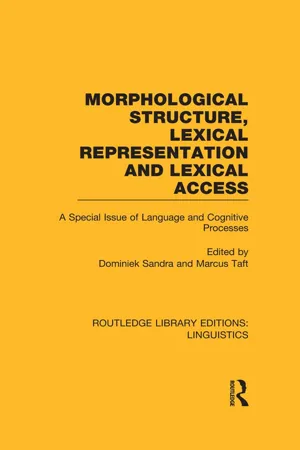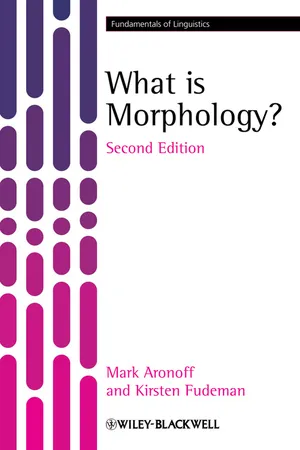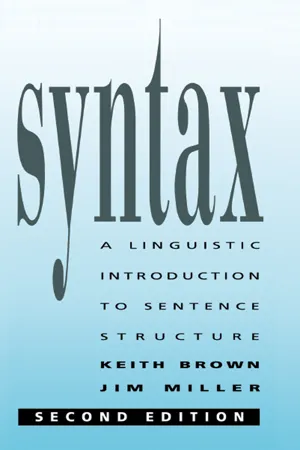Languages & Linguistics
Morphology
Morphology is the study of the structure and formation of words in a language. It focuses on the internal structure of words, including their roots, prefixes, suffixes, and other meaningful units. Morphology also examines how words are formed and how they can be modified to convey different meanings and grammatical functions within a language.
Written by Perlego with AI-assistance
Related key terms
Related key terms
1 of 4
Related key terms
1 of 3
11 Key excerpts on "Morphology"
- eBook - ePub
Sign Languages
Structures and Contexts
- Joseph Hill, Diane Lillo-Martin, Sandra Wood(Authors)
- 2018(Publication Date)
- Routledge(Publisher)
Chapter 3Morphology
In this chapter, we continue our discussion of sign language grammar, turning to the domain of Morphology . Morphology is the study of words, so in this chapter, we will look at how words are made in American Sign Language (ASL). We will discuss the ways that new words are formed, how words are modified, and the role of iconicity in ASL. The chapter also includes discussion of the way that the signing space is integrated in signs, and some morphological devices that seem to be special to sign languages.3.1 What is Morphology?
Morphology is the branch of linguistics that studies how words are formed from component parts. A morpheme is generally described as a consistent pairing of form (e.g., a sequence of sounds or a combination of handshape, location, and movement) and meaning, but there are morphemes that change their form in different contexts as well as those that don’t seem to have a consistent meaning.In spoken languages such as English, there are many words that are themselves a single morpheme, such as “cat,” “elephant,” “and,” and “behind.” Bear in mind that in English, a morpheme can have one, two, or more syllables – they are completely different notions. Words that contain two morphemes include “cats,” “walking,” and “rewrite.” The plural marking -s on “cats,” the progressive -ing on “walking,” and the prefix re- in “rewrite” contribute an additional morpheme that either makes a word fit a particular context (the usual role of inflectional Morphology), or changes the word into a new type with a new meaning (the usual role of derivational Morphology). In addition to inflectional and derivational Morphology, word formation is a component of Morphology. Word formation encompasses the various ways that new words are added to a language. We will discuss sign language examples of each of these types of Morphology in reverse order in the subsequent sections. - eBook - ePub
Applying Linguistics in the Classroom
A Sociocultural Approach
- Aria Razfar, Joseph C. Rumenapp(Authors)
- 2013(Publication Date)
- Routledge(Publisher)
6 Morphology Building Words with English Learners Learning Goals- Summarize the basic concepts of Morphology.
- Identify morphological processes.
- Understand different types of morphological systems in the world’s languages.
- Understand the difficulties ELs may have in learning English Morphology.
- Use derivational and inflectional rules in the classroom.
- Create a case study to analyze a particular topic in Morphology.
- Use morphological concepts in discourse analysis.
KEY TERMS/IDEAS: morpheme, lexeme, lexicon, derivation, inflection, agglutinating, fusional, isolating, nominalizationIn Chapter 5 we discussed the syntax, or grammar of language. Morphology is a related field in linguistics. Sometimes it is very difficult to distinguish what belongs to syntax and what belongs to Morphology because there is much overlap. What one language does in syntax, like through changes in word order as seen in the last chapter, another may do through Morphology, by changing the word itself. Therefore, it is often better to think about both fields together, as morphosyntax . In Chapter 5 , we focused more on how words (in the discrete analytic sense) relate to each other. In this chapter, we will examine how words are built internally to create distinct meaningful units. Morphology is the study of a language’s morphemes and the rules governing its transformations for communicative purposes. Morphemes consist of words, affixes, intonation, stress, and their implied or explicit contexts of use. In this chapter we will see how the traditional concept of “word,” especially in the isolated sense, constrains our view of how we learn, develop, and actually use language to make meaning.As we learn about the ELs in our classrooms, we need to be aware of the complexities of languages in the world. If we look at language only through our “English eyes” we will certainly misunderstand the way language is used by ELs. In this chapter we will attempt to build a way of thinking about words, how they are formed, and how they are used in a language system. We will also look at some common difficulties for ELs in English Morphology and attempt to understand the underlying issues as well as how to mediate classroom instruction for ELs. - eBook - ePub
Linguistics for Language Teachers
Lessons for Classroom Practice
- Sunny Park-Johnson, Sarah J. Shin(Authors)
- 2020(Publication Date)
- Routledge(Publisher)
4 MorphologyThe Analysis of Words
4.1 Introduction
So far in this book, we have seen how individual sounds are produced (Chapter 2 ), and how sounds pattern within a language to form meaningful utterances (Chapter 3 ). In this chapter, we proceed to examining a slightly larger linguistic unit—words. Words are a crucial part of our mental grammars. Without knowledge of words, we would not be able to get our meanings across to other people. Unlike phonemes and syllables, which operate only at the level of sounds, words carry meaning in addition to sounds. Words are also permanently stored in a speaker’s mental dictionary called lexicon. This permanence distinguishes words from phrases and sentences, which are pieced together with words as needed and then discarded when the need for them disappears (we will discuss sentence structure in Chapter 5 ). Quite simply, words are the building blocks of communication.What is a word? What does it mean when we say we know a word? Knowing a word means knowing both its sounds and its meaning. Every speaker of English knows that measure is an English word, as are measurement, measuring, measurable, and immeasurable. However, even though street is an English word, English speakers know that they cannot say any of the following: streetment, streeting, streetable, instreetable. How do English speakers know that adding -able to measure results in another word, but adding -able to street does not? Morphology tries to capture this knowledge, which is largely subconscious.Morphology is the study of the internal structure of words—how words are formed and what their relationships to other words are in the same language. It describes which meaningful pieces of language can be combined to form words and what the effects of such combinations are on the meaning or the grammatical function of the resulting word. For example, adding -able to measure modifies the grammatical function of measure, a verb, to an adjective, and it does so in the same way when attached to do (doable), or manage (manageable). Similarly, adding re- to type changes the meaning of type to indicate repetition, and it does so in the same way when added to generate (regenerate), or furbish (refurbish) - eBook - ePub
- Eunhee Lee, Sean Madigan, Mee-Jeong Park(Authors)
- 2015(Publication Date)
- Routledge(Publisher)
Morphology4.1 Basic Notions of Morphology
In the previous chapters, we talked about how different types of speech sounds in Korean are combined together to create words and phrases, and how each of these sounds affects its neighboring sounds in creating larger units. We focused on each segment, such as vowels and consonants, although we also dealt with suprasegmentals that affect larger units than segments. In this chapter, we expand our object of inquiry from individual speech segments to a bigger linguistic unit called the morpheme . Morphemes, the morphological building blocks of words, are defined as ‘minimal, irreducible linguistic units with a lexical or a grammatical meaning’ (Booij 2007, 9). Notice that ‘meaning’ is a keyword here. A single speech sound, such as [k], does not have any meaning on its own, but it is employed to make up certain words, for example, ‘cat’ [kæt], in which case the whole word carries a meaning (feline). In this particular case, the word ‘cat’ consists of only one morpheme, as one can see from the fact that it cannot be broken down into smaller units containing meaning. But words can also be constructed by putting together more than one morpheme, as in the case of ‘cats’. In this instance, ‘-s’ carries the meaning of ‘plural’, which is a grammatical, rather than lexical, meaning. Notice also that the method of making a plural form, i.e., adding ‘-s’ after a (countable) noun, is systematic and therefore rule-like. Morphology is a sub-discipline of linguistics that deals with systematic patterns of word formation rules and the internal constituent structure of words.4.1.1 Structure of Words
4.1.1.1 Paradigms and Morphological Rules
More often than not, words are built up by combining more than one morpheme. In such cases, we need to ask the following questions in order to discover the word structure: what morphemes does this word have? What does each of them mean? How are they combined? In order to answer these questions, we need to examine the relevant data closely. A paradigm - eBook - ePub
Everyday Linguistics
An Introduction to the Study of Language
- Joanne Cavallaro(Author)
- 2023(Publication Date)
- Routledge(Publisher)
CHAPTER 3 Morphology Word histories and structureDOI: 10.4324/9780429269059-3First glance- How do we put words together?
- Word formation processes:
- · When is borrowing theft?
- Word structure: Morphemes
- Derivational and inflectional morphemes
- Grammatical meaning
- Morphology in other languages
- Hierarchical structure of words
- Acquiring words
INTRODUCTION
Most people probably think of words as the basic, most important part of a language. When we learn a foreign language in school, aren’t we asked to memorize all those words at the end of each chapter? If we do memorize them, we’re often not much further along in learning to speak the language, though, because every language consists not only of a lexicon—a vocabulary—but also a phonological system, a morphological system, a syntactic system, and a grammar for putting them all together. Each system has a structure that we’ll examine in the following chapters. Here we’ll start with those words by examining Morphology, the study of words and their structure.What is it we know when we know a word? We know its meaning or meanings, its pronunciation or sign, how it’s used in a sentence, and how to use it appropriately. We know that, even within the same language, the word for something in one area may be totally different in another area. A submarine sandwich (or sub) in Minnesota, for example, is a hoagie in Philadelphia and a hero in San Francisco. We know that words vary across time as well as space; that is, they come and go. How many of you still speak of an ice box, a davenport, or consumption (refrigerator, sofa, and tuberculosis, respectively) or use slang terms like groovy or phat or rad?We know, even if we’re not aware of it consciously, that words are made up of separate parts that have meaning. Doors, for example, is made up of two parts, door and an {s} that means it is plural. We also know that each word is a particular part of speech (a noun or a verb, for example), what linguists call lexical categories - eBook - ePub
Speech to Print
Language Essentials for Teachers
- Louisa Cook Moats(Author)
- 2020(Publication Date)
- Brookes Publishing(Publisher)
5 Morphology for Reading, Spelling, and Vocabulary Chapter Goals •Explain the importance of Morphology for reading, spelling, and vocabulary •Categorize morphemes in English: prefixes, roots, suffixes •Identify Anglo-Saxon, Latin, and Greek influences on morpheme structures in English •Distinguish between inflectional and derivational suffixes •Recognize morphological errors in speech, reading, and spelling •Review assessment of morphological knowledge •Identify morphological awareness development across the grades •Practice examples of explicit teaching activities to develop morphological awarenessWHAT IS Morphology?This chapter concerns units of meaning called morphemes—linguistic entities that may be whole words, parts of words, or single phonemes. They are more than “word parts.” Morphemes are the smallest meaningful units in language. Morphology is the study of these meaningful units of language and how they are combined in word formation. Once again, English is a “deep” orthography—it represents both sound and meaning, and is thus morphophonemic. Recognition of and memory for morpheme structure help us decode, spell, and understand the meaning of words as we expand our vocabularies and become fluent readers and writers. Morphology, like phoneme–grapheme correspondences and orthographic patterns, can and should be taught explicitly in any word study program.WHY KNOWLEDGE OF MORPHEMES IS IMPORTANTKnowing morphemes enhances reading comprehension, word recognition, vocabulary, and spelling.1 Awareness of morphemes is one aspect of a verbally proficient person’s word knowledge. Since the demise of Latin in the high school curriculum, however, it is uncommon for instructional materials to systematically teach and explain these structural components of language. Such an omission is unfortunate because rapid word recognition, independent discovery of word meaning, and spelling accuracy are all associated with knowledge of word structure at the level of morphemes. Recent research indicates that morphological awareness is associated with reading and spelling growth from first grade onward, in parallel with phoneme awareness and general print knowledge.2 Therefore, teachers at all levels should understand Morphology, especially if they are to teach advanced word study in the intermediate grades and beyond.3 - eBook - ePub
- Bruce M. Rowe, Diane P. Levine(Authors)
- 2022(Publication Date)
- Routledge(Publisher)
Three kinds of synthetic language types were discussed: inflectional, agglutinating, and polysynthetic. In reality, most languages mix the typological principles to various degrees.Morphemes may have different phonemic shapes. The phonemic shape that is used depends on the sound characteristics of the morphemes being combined. Because both Morphology and phonology are involved in these subconscious decisions, the study of them is called morphophonemics.New words are constantly entering languages. The processes of compounding, blending, acronym formation, foreign word borrowing, clipping, derivation, back-formation, using proper names, and using trade names are some of the more common ways that new words are formed.Words can be divided into types and subtypes depending on their meaning, how they function in a sentence, how they are inflected, and other criteria. One system of doing this, dividing words into the lexical categories, was described in Table 4.1 .Suggested reading
- Aronoff, M., and Kirsten Fudeman, What Is Morphology? 2nd ed., Malden, MA: Wiley-Blackwell, 2011.
- Barnhart, Robert K., and Sol Steinmetz, eds., Chambers Dictionary of Etymology , Edinburgh: Chambers, 1999.
- Bauer, L., Introducing Linguistic Morphology , 2nd ed., Washington, DC: Georgetown University Press, 2004.
- Coates, Richard, Word Structure , London: Routledge, 2000.
- Crystal, David, Words, Words, Words , New York: Oxford University Press, 2007.
- Haspelmath, M. and Andrea D. Sims, Understanding Morphology
- eBook - ePub
- Keith Allan, Keith Allan(Authors)
- 2015(Publication Date)
- Routledge(Publisher)
lunch .7.3 The place of Morphology in grammar
The position of Morphology in the architecture of the grammar of natural languages has been debated for decades in the linguistic literature, and it is impossible to summarize this debate in detail in this chapter.In a syntactic approach, Morphology is defined as the ‘syntax of morphemes’ and the way in which morphemes are combined is accounted for by the same syntax that accounts for the construction of sentences from words. The most recent form of this approach is the theoretical framework of Distributed Morphology (Harley and Noyer 1999; Marantz 2013).In the lexicalist approach to word formation, on the other hand, there is a separate morphological component in the grammar that accounts for word formation, and precedes the syntactic component that serves to combine words into grammatical sentences. This component enriches the lexicon of a language which provides the words that can be used in the construction of sentences. The inflectional forms of a word may be generated pre-syntactically, or post-syntactically. In the first option, the proper inflectional form of a word in a particular syntactic context is selected by syntactic rules such as agreement rules; in the second option, the stem of words is selected for lexical insertion into syntactic structure, and this stem is then operated upon by the post-syntactic rules of inflection. For instance, the verb form sings in My father sings wonderfully is either selected as the proper form (third person singular present tense) by the rule of Subject–Verb agreement, or this rule assigns the features [third person singular] to the present tense stem sing , and this configuration is then spelled out as sings - eBook - ePub
Morphological Structure, Lexical Representation and Lexical Access
A Special Issue of Language and Cognitive Processes
- Dominiek Sandra, Marcus Taft, Dominiek Sandra, Marcus Taft(Authors)
- 2014(Publication Date)
- Routledge(Publisher)
In textbooks on Morphology and in introductory courses to general linguistics, morphemes are almost invariably defined as the smallest linguistic units of form and meaning. In accordance with this definition, an English word like boys is said to consist of the stem morpheme boy and the plural suffix - s, as these segments reveal a constant form-meaning relationship across the English lexicon. Examples attesting to their morphemehood are boyish, boyhood, boy's school, boy's book for boy and cats, mugs, dolls for - s. Can psycholinguists modelling the mental lexicon rely on this traditional definition of the morpheme for making proposals on the way polymorphemic words are represented? It is very tempting to answer this question in the affirmative. Indeed, the definition almost naturally suggests that Morphology could be put to the purpose of reducing the amount of information to be stored for these words in the mental lexicon. Two variants of this idea are discussed below with respect to different types of polymorphemic words, and then the explanatory nature of the concept of representational economy is evaluated. The Mental Lexicon as a Morpheme Inventory If the above definition is correct, the morpheme rather than the word could be considered as the basic unit of lexical description. If words can be broken down into their constituent morphemes and the latter behave as constants of form and meaning, it must be possible (even desirable) to treat words as simple integrations of morphemic units, at the levels of both form and meaning. Within such a “building-block” perspective, the word itself is epiphenomenal and uninteresting for a scientific study of the lexicon. Its formal and semantic aspects being rule-governed, it would seem to claim the same status in the lexical realm that sentences have in syntax - eBook - ePub
- Mark Aronoff, Kirsten Fudeman(Authors)
- 2011(Publication Date)
- Wiley-Blackwell(Publisher)
3 Morphology and Phonology- 3.1 Allomorphs
- 3.2 Prosodic Morphology
- 3.2.1 Phonotactic constraints
- 3.2.2 Root-and-pattern Morphology
- 3.2.3 Reduplication
- 3.3 Primary and Secondary Affixes
- 3.4 Linguistic Exaptation, Leveling, and Analogy
- 3.5 Morphophonology and Secret Languages
- 3.6 Summary
- Kujamaat Jóola Morphophonology
- Vowel harmony
- A secondary affix
- Further Reading
This chapter explores some of the many interactions that take place between Morphology and phonology. These interactions and the grammar that describes them are often called morphophonology or morphophonemics. We begin by looking at phonological processes such as assimilation and the effect they have on the shapes of morphemes. We then consider limitations on the phonological shape of morphological entities such as words and stems. From there we move on to two general types of affixes that are distinguished, in part, by phonological criteria. Their phonological behavior reveals details about their underlying structure and the point at which they attach to their bases. We conclude with a look at secret languages in which Morphology and phonology interact to disguise the shapes of words.We wrote in the preface that we expect our readers to have the rudimentary knowledge of linguistics that comes from taking an introductory course. To understand the discussion in this chapter, you need to know three terms that are often not introduced in such courses. They are onset, nucleus, and coda. The onset of a syllable is made up of the first consonant or consonants. The nucleus is the syllable’s core, usually a simple vowel or a diphthong. The coda is made up of the consonant or consonants that follow the nucleus. All syllables must have nuclei. Onsets and codas are optional, though some languages require the former.3.1 AllomorphsThe term ‘allomorph’ was introduced in the first chapter, in two contexts. In Kujamaat Jóola, we noted that the stem /baj-/ has two possible shapes, [baj-] and , with occurring in the presence of a morpheme with an underlyingly tense vowel, and [baj-] elsewhere. In English, the plural marker comes in several shapes, among them [s] as in lips , [z] as in balls , [ z] as in roses , as in oxen , and null as in sheep . In this chapter we are most interested in alternations based purely on phonological context, as with the Kujamaat Jóola facts. In the English data, only the first three allomorphs of the plural suffix depend on phonological context. The last two, as in oxen and sheep - eBook - ePub
Syntax
A Linguistic Introduction to Sentence Structure
- Keith Brown, Jim Miller(Authors)
- 2020(Publication Date)
- Routledge(Publisher)
mace may realize either the lexeme MACE(1) with the sense ‘spice’ or the lexeme MACE(2) with the sense ‘staff of office’ – a fact usually recognized in dictionaries by according each lexeme a different entry.2 In section 12.3 we distinguished between ‘word and paradigm’ and ‘item and arrangement’ models of Morphology. In the former the grammatical word will generally be the head lexeme and its associated features (e.g. laughed:LAUGH[past] , or LAUGH[past part] ); in the latter the grammatical word will be a string of morphemes (e.g. laughed: {LAUGH + past} or {LAUGH + past part}.3 The sentences are represented in the orthographic form. Tone markings have been omitted, although these are also relevant to a complete description of the verbal system. This does not affect the point at issue.Passage contains an image
13 Morphemes and morphs
In the previous chapter we established a distinction between morphemes, abstract units used in the grammar, and morphs, concrete units that are ‘parts of words’. We described the relation between the abstract morpheme and the concrete morph as one of realization. In this chapter we look at different kinds of morphs and begin to explore realization.13.1 Morphs
When a word form can be analysed into smaller forms, which cannot themselves be analysed into yet smaller forms, the smaller forms are morphs. A morph is thus a word form (if it cannot be analysed) or part of a word form. In this section we introduce some terminology for talking about morphs.Word forms that can be analysed into a string of two or more morphs are morphologically complex. Word forms that consist of a single morph are morphologically simple; walk-ed is morphologically complex; went or ran is morphologically simple.A morph that can stand alone as a word is a free morph; boy, tea, time, half, back, happy and long are free morphs. A morph incapable of standing alone as a word is a bound morph: -ish, un-, -ed and -ness in boy-ish, un-happy, walk-ed and good-ness are bound morphs. We show bound morphs preceded or followed by a hyphen: -ish, -un
Index pages curate the most relevant extracts from our library of academic textbooks. They’ve been created using an in-house natural language model (NLM), each adding context and meaning to key research topics.
Explore more topic indexes
Explore more topic indexes
1 of 6
Explore more topic indexes
1 of 4


